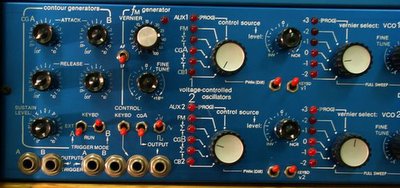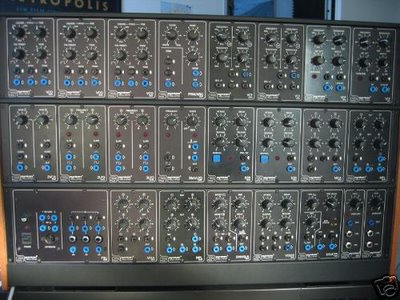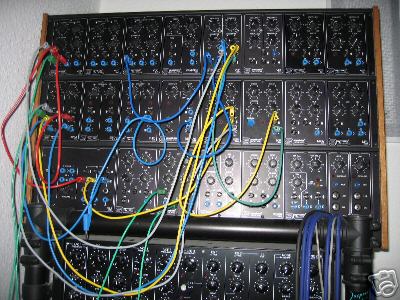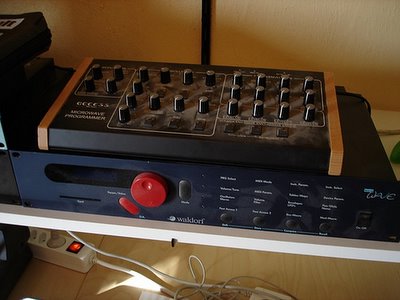Showing posts with label Wavemakers. Show all posts
Showing posts with label Wavemakers. Show all posts
Tuesday, June 03, 2008
Malekko Sequencer Demos
YouTube via malekko1. Note the blinky knobs. The sequencer is driving a Roland SH-101.
Malekko Sequencer Demo 1
"Malekko Sequencer Live Mode, Quantization Tables and Presets"
Malekko Sequencer Demo 2
"Malekko Sequencer Daisy Chain, Tap Rhythm and Edit Preset"
Malekko Sequencer Demo 3
"Malekko Sequencer Random controls"
via Josh Holly:
"Here are some videos of the new Malekko sequencer. The first one is a little long and boring but two and three get into some features that have never been offered in a sequencer before.
This is a joint effort between Malekko and John Loffink from http://www.microtonal-synthesis.com [and Wavemakers].
The sequencer features:
24 presets,
CV gate
as many as 24 steps per sequence
quantizer with multiple scales
variable random note step and note length
tap tempo and tap rhythm
variable slide per step
its a small and very powerful sequencer, it's one of those things that 2 hours have passed while you're messing with it.
this is the prototype, the production model will have a 2 digit display for keeping track of what sequence you're on. and will have graphics.
www.malekkoheavyindustry.com"
Be sure to check out the prior Malekko posts by clicking on the label link below.
Wednesday, September 05, 2007
Wavemakers Site Updated
via John Loffink on AH:
"Some more Wavemakers Modular Systems photos, and photo of a Table Top 658 Digital Sequencer after clean up and repairs.
Start here
And here
John Loffink
The Microtonal Synthesis Web Site
The Wavemakers Synthesizer Web Site"
Tuesday, September 04, 2007
SMS - Salamander Music Systems Data Sheets
via John Loffink on AH:
"I have posted data sheets for Salamander Music Systems modular synthesizers, from around 1980. There are 30 pages, scanned at 150 dpi, all in one zipped file. Most of this information is excerpted in the excellent SMS web site.
SMS Data sheets
John Loffink
The Microtonal Synthesis Web Site
The Wavemakers Synthesizer Web Site"
 Below: Programmable Envelope Generator 240
Below: Programmable Envelope Generator 240PEG-240
Wednesday, August 08, 2007
EVOS Modular Scans

Via Mike Peake on AH:
"From 1997 through 1999, Dennis Graham advertised a new modular synthesizer of his own design. I was in contact with him, and received literature on the system. I believe that I contacted him again in the early 2000s; there may be a post from me on AH confirming this, when the name EVOS comes up every now and again.
I tried phoning and emailing him today; his phone number is disconnected and I have neither received an email bounce nor an answer (although only an hour or so has gone by- the foibles of the information age! If it isn't instant, it may not exist!). I didn't want him inundated with the curious, but if he answers, I'll post about what he's up to.
Pardon the quality of the scans; the machine I used didn't press down on the papers, so the folds cause curving of the images in places! They are lower quality due to there being 20 pages; perhaps I can send the lit to Joe at the Audio Playground for true archive-level scanning."
On flickr
And via John Loffink of The Microtonal Synthesis Web Site and The Wavemakers Synthesizer Web Site
"I don't know if Dennis ever made prototypes, but circa 2002 he did confirm that he never shipped any systems."
EVOS_01.jpg
EVOS_02.jpg
EVOS_03.jpg
EVOS_04.jpg
EVOS_05.jpg
EVOS_06.jpg
EVOS_07.jpg
EVOS_08.jpg
EVOS_09.jpg
EVOS_10.jpg
EVOS_11.jpg
EVOS_12.jpg
EVOS_13.jpg
EVOS_14.jpg
EVOS_15.jpg
EVOS_16.jpg
EVOS_17.jpg
EVOS_18.jpg
EVOS_19.jpg
Wednesday, July 25, 2007
Marsona

Another Marsona sleeping aid device. Click here for a couple more shots via this auction.
Not the best shots, so check out this post for a better one and some more info. Note the description on this one below states wave oscillators in addition to white noise makers. Anyone know what the "wave oscillator" is in reference to and how it sounds? Seagulls to go along with the ocean?
"Pair of vintage mid 70's Marsona brand Wave Oscillators/White Noise makers. One is a Marsona 1200 and the other is a Marsona 1220 both have been equipped with 1/4" Output jacks so you can plug these into pedals and amplifiers very cool synth sweeps and white noise wave machines."
Tuesday, July 24, 2007
Hataken Interview

Back on March 31, I put up a post on Hataken, a Japanese DJ artist who primarily uses analog synths. At the time, Shane Chisolm, the manager of Don Juan Dracula mentioned Hataken was working on a remix version of DJD's "Take Me Home". Shane asked me if I'd be interested in doing an interview with Hataken, and I thought why not. It would be interesting to hear his perspective on the world of synths as a live DJ artist. The following is the result of that interview. Note, this is a long one. You will want to use page down to scroll through. If it is too long for you, I recommend reading one or two questions each time you visit the site. Each DIY item below would typically have been a separate post. There is a lot of interesting stuff here. That said, I start with an introduction followed by asking Hataken how it all started for him. Note the focus is primarily on synths as this site is about everything synth, and Hataken delivers. The gear he has both worked with and designed to meet his specific needs is overwhelming. There's also an interesting interlude on experimenting with frequency counters to produce specific frequencies of sound known to have healing properties, and of course there is a bit of the age old discussion of digital and analog.
Before we start the interview, I want to thank Hataken for taking the time out for this, and I want to thank Shane for suggesting it. It's a fascinating history of a DJ synth artist with interesting perspectives that I'm sure I will come back to over time. Be sure to check out the video and link to more at the end. And of course be sure to check out Hataken's website.
1. Can you tell us a little bit about yourself?
LABELS/MORE:
Alternate Controllers,
Delta Music Research,
DIY,
Eventide,
Future Retro,
Highly Liquid,
Metalbox,
MOTK,
SynTom,
Ultimate Sound,
Wavemakers
Thursday, June 28, 2007
Serge Modular
Click here for shots via this auction.
Details:
"SMOOTH FUNCTION GENERATOR, NOISE SOURCE, DUAL ANALOG SHIFT REGISTER, DUAL UNIVERSAL SLOPE GENERATOR, DUAL PHASER, UNIVERSAL EQUAL POWER AUDIO PROCESSOR, TIMBRAL OSCILLATOR, PRECISION VCO (TWO OF THESE), WAVE MULTIPLIER, VARIABLE Q VCF, DUAL TRANSIENT GENERATOR, DUAL AUDIO MIXER, TOUCH ACTIVATED KEYBOARD SEQUENCER.
Serge gets its name from Serge Tcherepnin (pronounced "Cher - epp - nin"), a multitalented composer and electronic designer born of Russian-Chinese parents and raised in France. Self-taught in electronic design and circuit building, Serge enjoyed doing 'junk electronic' projects early on, making tape compositions using various electronic noisemakers cobbled together out of transistor radios and the like.
After studying music and physics at Harvard and Princeton, he taught music composition at the California Institute of the Arts. This was the early 70's, the heyday of Moog, ARP, and Buchla synthesizers. Calarts had a few Buchla-equipped studios. These were expensive, highly sought-after instruments, kept under lock and key. Getting studio time on one at Calarts meant being either a recognized staff composer or someone who maneuvered themselves into favor. The Buchla, ARP, and Moog synthesizers were interesting in their way, but could be improved upon. They were both expensive and bulky, a system with a decent number of functions could take up a whole wall in a small room. Serge and students Rich Gold and Randy Cohen wondered what they could do about this. After kicking around some ideas, they decided they were going to do their own synthesizer.
The first modules were designed, soldered, and built at Serge's home in what was essentially a kitchen tabletop operation. Before long, the word got out to other professors, students, and musicians about this new synthesizer. They wanted a piece of the action. Serge set up a strange sort of guerrilla manufacturing operation at Calarts on a second-story courtyard balcony. People paid $700 upfront for parts, worked on the 'assembly line' soldering and building modules, and eventually got themselves a six-panel system. Somehow, the Calarts administration either didn't find out or wasn't too bothered by this.
Another interesting player in this drama was composer Morton Subotnik, a professor at Calarts. He had a long association with instrument designer Don Buchla in the early 60's, the two of them collaborating on fundamental aspects of synthesizer design. When Mort spoke, Don listened. Serge caught on to this, and sought to woo Morton away from the Buchlas, but that was difficult. Eventually, Serge did build Mort some custom equipment.
In the 70's Serge collaborated on the design and construction of TONTO, a large polyphonic modular system. TONTO had the ancestry of many early Serge designs, some packaged behind faux-Moog front panels, including the NTO.
Serge eventually quit teaching and began to build synthesizers more seriously, using the first designs as a springboard. The Serge company was started in 1975, in the West Hollywood area, then headed north to San Francisco's Haight Street a few years later. It was always a humble bohemian concern, running more on enthusiasm and the love of making music than money and hardheaded business sense. Business tapered to a trickle in the middle 80's, and Serge, to support his family, started doing various outside electronic consulting projects. In 1992 Serge decided to move back to France. It was at this point that he sold the closely-guarded circuit designs to longtime associate Rex Probe, who then founded Sound Transform Systems. Production record keeping was pretty informal; it's estimated that "hundreds" of Serge systems were produced in the early years.
Today, Serge is again doing musical composition and is involved in helping Russian Jews move to Israel.
As Moog was a powerful East Coast influence that inspired ARP and Polyfusion, Buchla was the West Coast influence on Serge. Several Buchla designs, including the use of touch sensitive nontraditional keyboards, sequencers, random voltage generators, function generators, and matrix mixers found their way into Serge's repertoire. But that's not to say that Serge is merely a Buchla clone. Serge made many unique contributions, including the wave multiplier module, and some ideas were taken to new heights. Serge's oscillator designs have extraordinary accuracy and stability, especially considering their discrete nature. His philosophy of allowing the easy interplay of audio, control, and trigger signals, combined with the use of banana plugs, makes these systems wonderfully flexible.
There's no denying the amazing staying power of the Serge designs. Largely because of the development of convenient microprocessor-based keyboard synths, the 80's were a nasty time for analog synthesizer makers, practically all of them throwing in the towel. Serge's business slowed way down but never completely went out of production. With the recent clamoring for analog gear fueling successful production, Rex Probe and Sound Transform Systems look poised to carry the cream of analog modular music synthesis over the threshold of the 21st century, into their fourth decade of realization.
Sound Transform Systems has done a great job of continuing the analog modular lineage. Most of the traditional Serge modules are there, a few old ones were dropped, a few new ones added. The details are constantly being improved in many visible and invisible ways. They are still laboriously handmade, though the entire build process has been improved. Turnaround time has been improved from several months to 'just a couple'. All the components are top notch. The panel graphics and layout of many of the modules have been redesigned to make them more compact while keeping or improving the functionality. The circuit designs on many modules have been updated."
Sunday, May 13, 2007
Waldorf Demo CDs and Music

This one came in on the Waldorf list. Dr. Georg Müller had the following to say:
"I think it is the first Demo CD Waldorf was releasing, before they only had Music Cassettes. Back in that time the Music for the Demos was more Rock/Pop than in the later years. There is no release date on the CD, but it has to be around 1996.
4 Songs on the CD
1. Planet Wave by Peter Gorges (vocals by Macintalk)
2. Like a Wave by Christian Ledwig (vocals by Axel Hartmann)
3. This Wheel´s on Fire by Peter Gorges (vocals by Hilmar Kusenberg)
4. Cyberscore by Peter Gorges
Guitar on 2. and 3. by Rocco Klein
Pulse, MicroWave, WAVE and Sampled Drums
At Musicmesse in Frankfurt they released that CD and has the songs played live in their closed showroom. The year before they did that as well, they had Saga Keyboarder Jim Crichton in the show and they played "Scratching the Surface" beside other stuff. There is no record of that session from what I know.
The CD in 1998 was then "Alien Control" based on MWII/XT and Pulse.
Peter Gorges later did a series of Planet Wave Songs which where up on mp3.com for a while, here is one reference to be found:
http://www.memi.com/cd/2001/track209.html
http://www.memi.com/makers/sclips/ht4/mp3/ht4-clip209.mp3"
Followed by:
"The "Planet Wave" CD is labeled "Waldorf Project", the CD "Alien Control" is labeled "Waldorf Project2" and the CD "main output" is labeled "Waldorf Project3"
So the years are more like this
1997 - Waldorf Project - Planet Wave
1998 - Waldorf Project2 - Alien Control
1999 - Waldorf Project3 - main output
The Tape Phase was started in 1990 with the "Micro - Wave Demonstration Tape 1", there was a WAVE Demo Tape later."
Sunday, February 04, 2007
Analog Lab X-32

Remember the Analog Lab X-32
Click here for a few more shots sent my way via John of The Microtonal Synthesis Web Site and The Wavemakers Synthesizer Web Site.
Update: You can find some mp3s and the french manuals here. Also courtesy of John.
Sunday, December 24, 2006
Bank Step Now Free
Remember Algorithmic Arts
John Loffink of Microtonal Synthesis and Wavemakers wrote in to let me know that their Bank Step analog style sequencer is now free.
Wednesday, August 30, 2006
Wavemakers
 I wasn't going to put this up as I've already posted on Wavemakers several times in the past, but the day is actually starting out slow and why not. This is a spectacular shot, and if it's good enough to post on sequencer.de and sendling, then it's good enough to post here. If you haven't been to the Wavemakers site, do check it out. Wavemakers was an amazing range of modular synths that not too many people know about. "The pages you see here are a tribute to the work of Dr. Terry Kincaid and Dr. David S. Bates. This site is dedicated to chronicling and preserving the history of Wavemakers, also known as kb electronic music instrumentation. This line of synthesizers was produced from 1970 to the early 1980s." Title link takes you there.
I wasn't going to put this up as I've already posted on Wavemakers several times in the past, but the day is actually starting out slow and why not. This is a spectacular shot, and if it's good enough to post on sequencer.de and sendling, then it's good enough to post here. If you haven't been to the Wavemakers site, do check it out. Wavemakers was an amazing range of modular synths that not too many people know about. "The pages you see here are a tribute to the work of Dr. Terry Kincaid and Dr. David S. Bates. This site is dedicated to chronicling and preserving the history of Wavemakers, also known as kb electronic music instrumentation. This line of synthesizers was produced from 1970 to the early 1980s." Title link takes you there.
Tuesday, June 20, 2006
Analog Renaissance on Electronic Musician Online
Click here for an 861kb pdf of the Analog Renaissance article in Electronic Musician. The article features the Cyndustries ZeroOscillator, pictured.
Via John Loffnick on the Cyndustries mailing list. You might recognize John Loffnick of The Microtonal Synthesis Web Site and The Wavemakers Synthesizer Web Site.
BTW, I love it when magazines put full articles online. Thank you Electronic Musician.
Tuesday, May 16, 2006
Wavemakers - New Shots and New Samples Up
You can find them here. When you get there, click on the music knob for new samples and click on the photos knob for new shots.
Tuesday, March 07, 2006
New Shots on the Wavemakers Site
John Liffink put up two new shots up on the Wavemakers site. Click on the Next Page link when you get there to see the second shot. I found the shots look better when saved locally and shrunk down a little.

Update via the comments:
chris said...
Have a listen to the MP3's, they are top shelf modular sounds !!!

Update via the comments:
chris said...
Have a listen to the MP3's, they are top shelf modular sounds !!!
Saturday, December 31, 2005
New Wavemakers Shots
I previously posted on John Loffink's Wavemakers site back on November 24. John just put up some new shots of the Wavemaker modular and sequencer (pictured below). The shots came in from Jason of SRRecords. Links to the new shots below.

http://www.wavemakers-synth.com/wmmodpic4.html
http://www.wavemakers-synth.com/658pic1.html

http://www.wavemakers-synth.com/wmmodpic4.html
http://www.wavemakers-synth.com/658pic1.html
Thursday, November 24, 2005
Wavemakers
Title link takes you to John Loffink's Wavemakers website, home to an obscure and fascinating line of modular synths during the 70s and early 80s. The site covers the history of Wavemakers, photos, music, catalog, documents and links. Make sure to check out the history for a fascinating and unfortunately sad story behind Wavemakers. Also make sure to check out John's Microtonal web site.

"Wavemakers was a mobile operation, beginning in Ann Arbor, Michigan, later moving to Edmonds, Washington. The company began in 1970 around the University of Michigan, creating custom modules for the university and area musicians. These were large format modulars with varied size control knobs and 1/4 inch jacks. "
"Wavemakers was the brand of synthesizers and electronic music equipment created by "kb electronic music instrumentation," initially a collaborative effort between Terry Kincaid and David Bates. Their company officially started in 1970 and continued until the early 1980s."
"Terry died unexpectedly of pneumonia in February 1995. Hard working to a fault, he was on the phone that very day helping customers of the software company that he worked for, and tragically considered himself too busy to go to the hospital for medical help.
Barton McLean recalls an anecdote about Rick Petersen's "Natural Causes," a piece of music accomplished on the Wavemaker 4. Barton sent it to Terry Kincaid, who was deeply moved. Terry sent a letter back saying that after hearing Rick's piece he realized why he worked so hard at developing new instruments. David S. Bates passed away in 1974 and Terry Kincaid passed away in 1995, but their Wavemakers instruments leave a legacy that is just now being rediscovered."

"Wavemakers was a mobile operation, beginning in Ann Arbor, Michigan, later moving to Edmonds, Washington. The company began in 1970 around the University of Michigan, creating custom modules for the university and area musicians. These were large format modulars with varied size control knobs and 1/4 inch jacks. "
"Wavemakers was the brand of synthesizers and electronic music equipment created by "kb electronic music instrumentation," initially a collaborative effort between Terry Kincaid and David Bates. Their company officially started in 1970 and continued until the early 1980s."
"Terry died unexpectedly of pneumonia in February 1995. Hard working to a fault, he was on the phone that very day helping customers of the software company that he worked for, and tragically considered himself too busy to go to the hospital for medical help.
Barton McLean recalls an anecdote about Rick Petersen's "Natural Causes," a piece of music accomplished on the Wavemaker 4. Barton sent it to Terry Kincaid, who was deeply moved. Terry sent a letter back saying that after hearing Rick's piece he realized why he worked so hard at developing new instruments. David S. Bates passed away in 1974 and Terry Kincaid passed away in 1995, but their Wavemakers instruments leave a legacy that is just now being rediscovered."
Wednesday, November 23, 2005
Synton Modular
Update via the comments. Cool. Thanks John!
"Synton 3000 Modular Documents
These documents are from 1984 when Big Briar, Bob Moog's company, was distributing Synton in the US. The Synton 3000 appears to be a modest and cost effective but capable system. This is a banana jack system.
http://www.wavemakers-synth.com/synton/Synton_3000.html
For other interesting historical synths visit my Wavemakers site linked below.
John Loffink
The Microtonal Synthesis Web Site
http://www.microtonal-synthesis.com
The Wavemakers Synthesizer Web Site
http://www.wavemakers-synth.com
--------------------------------------------------------------
Synton Modular on the bay. Via Luca of SYTHOSIUM. Title link takes you to his site with some other interesting items including Snoop's Minimoog! : ) Thanks Luca! Two shots saved for posterity:


"Synton 3000 Modular Documents
These documents are from 1984 when Big Briar, Bob Moog's company, was distributing Synton in the US. The Synton 3000 appears to be a modest and cost effective but capable system. This is a banana jack system.
http://www.wavemakers-synth.com/synton/Synton_3000.html
For other interesting historical synths visit my Wavemakers site linked below.
John Loffink
The Microtonal Synthesis Web Site
http://www.microtonal-synthesis.com
The Wavemakers Synthesizer Web Site
http://www.wavemakers-synth.com
--------------------------------------------------------------
Synton Modular on the bay. Via Luca of SYTHOSIUM. Title link takes you to his site with some other interesting items including Snoop's Minimoog! : ) Thanks Luca! Two shots saved for posterity:


Sunday, November 13, 2005
Access Programmer - New Flickr Shot
Access, makers of the Virus line of synths made knob boxes for the Oberheim Matrix1000 and the Waldorf Wave rackmount. Pictured below is the Access programmer for the Waldorf Wave.


Monday, August 15, 2005
More Buchla Bits
Click here for an interesting read on a visit by Don Buchla to Cikira's Mushroom Studio.
Music Easel PDF
History of Buchla's Instruments PDF
PREVIOUS PAGE
NEXT PAGE
HOME













© Matrixsynth - All posts are presented here for informative, historical and educative purposes as applicable within fair use.
MATRIXSYNTH is supported by affiliate links that use cookies to track clickthroughs and sales. See the privacy policy for details.
MATRIXSYNTH - EVERYTHING SYNTH













© Matrixsynth - All posts are presented here for informative, historical and educative purposes as applicable within fair use.
MATRIXSYNTH is supported by affiliate links that use cookies to track clickthroughs and sales. See the privacy policy for details.
MATRIXSYNTH - EVERYTHING SYNTH
































